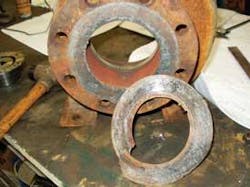Why Do Pump Flange Gaskets Leak?
by Robert L. Matthews
A troubleshooting guide is what we need, and this article will cover some of the troubles that I see in my job as I customize maintenance training for plants. First, we must know a little about the flanges that we seal.
The new raised and flat machined flange faces are made with a finish that appears to be phonographic or concentric. We can all agree that these grooved-to-a-raised-point surfaces are made to bite the gasket and this makes the seal. Still we have leaks and gasket material stuck to the flange sealing surfaces and that isn’t what we want.
Why do gaskets stick to the flange faces? The many answers to this question differ with who’s answering the question. The one I hear too often is there wasn’t enough never-seize a thread lubricant that will make some gaskets leak on the gasket. Use of any gasket compounds is prohibited by gasket manufacturers. If it’s necessary to hold a gasket in position, then it’s suggested to use a light spray of an adhesive like 3M Super 77. Most sticking gaskets are ones made of fiber and glue that are tightened so much the glue is squeezed into the pores of the metal. That bond is the problem. The gasket surface should be cleaned with a brass brush or one that doesn’t layover or dull the metal sealing surface points. Power-driven rotary brushes, like grinders with wire wheels, can alter this sealing surface to the point sealing is difficult. Gasket scrapers made for cylinder block surfaces and putty knives can gouge into the phonographic surface and create more problems if the gouges go too deep. Gasket companies have designed gaskets with a release agent in them to help prevent sticking when they’re installed correctly. They also can educate their customers on the art of proper sealing. They don’t recommend you take a tube of silicone caulk and lay a bead down on the gasket to help the seal, as some compounds can chemically attack the gasket.
Spiral wound gaskets have some of the same issues and many good features. They were developed for high heat and high pressure in the early 1900s by Flexitallic and, in the old days, offshore platform workers and pipe fitters didn’t say spiral wound they asked for Flexitallic gaskets. Today, with several companies making spiral wound gaskets, there are so many new types and improvements in them that selection requires some research. Centering these gaskets in place is critical and many are made so they’ll be in the center like gaskets cut from sheet material. Flanges using these gaskets need a minimum of cleaning after removal of the gasket.
Sheet gasket material varies in too many materials to try to cover here and work well enough when applied correctly. This is true for ring and other gaskets as well.
I can’t not mention expanded PTFE as it’s one gasket we could never be without at Royal Purple and it does a good job on sealing man-ways and pipe flanges. Sealing jobs today can be accomplished with a number of industry materials at our finger tips. Following manufacturers’ guidance is more important than ever, since your life might be the one the gasket protects.
Why do the gaskets leak? One answer, but very often the wrong answer, is the gasket isn’t good enough. Actually, it’s more correct to say that a joint leaks and not a gasket. Factors like flange surface finish, flange flatness/parallelism, bolt size/material, gasket type/material are a few to study based on the medium and pressure/temperature involved. There are many gasket materials designed to meet various sealing applications. Knowing the sealing application and applying the correct gasket is a joint effort for maintenance personnel and the gasket supplier.
What’s the solution to the problem? The No. 1 but wrong solution is to get a thicker gasket or increase the torque. In the case of a sheet gasket, thinner the better. Follow the plant specs, equipment specs, and get help from your gasket manufacturer.
About the Author: Reliability manager for Houston-based Royal Purple Ltd., Bob Matthews has 35-plus years of pump industry experience from hands-on to supervision in plant maintenance management, consulting and training. He has taught advanced pump classes for companies like Exxon, Phillips, Westinghouse as well as Auburn, University of Alaska, LSU, the Vibration Institute, ASME and FSA.

